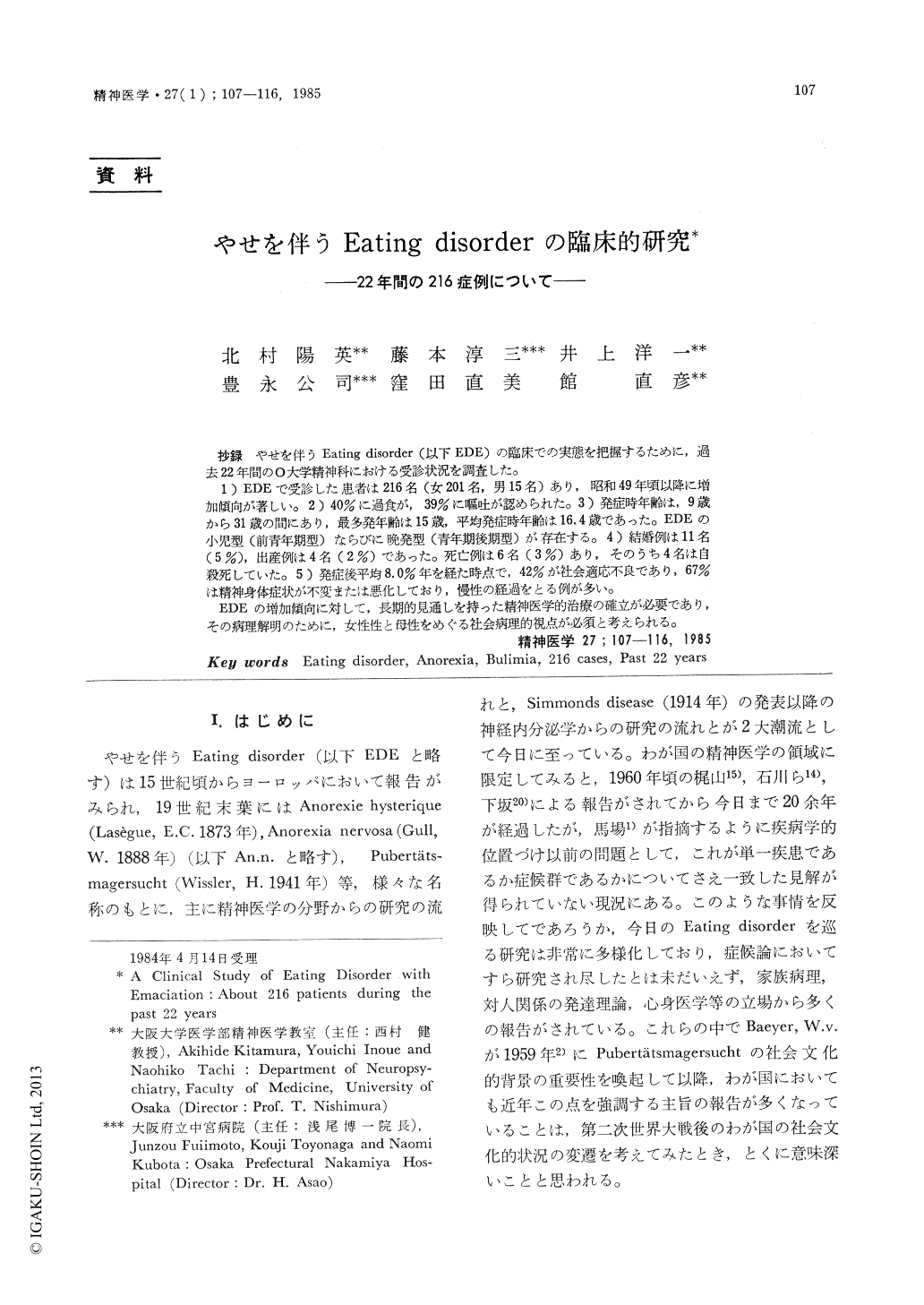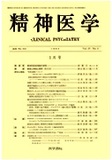Japanese
English
- 有料閲覧
- Abstract 文献概要
- 1ページ目 Look Inside
抄録 やせを伴うEating disorder(以下EDE)の臨床での実態を把握するために,過去22年間の0大学精神科における受診状況を調査した。
1)EDEで受診した患者は216名(女201名,男15名)あり,昭和49年頃以降に増加傾向が著しい。2)40%に過食が,39%に嘔吐が認められた。3)発症時年齢は,9歳から31歳の間にあり,最多発年齢は15歳,平均発症時年齢は16.4歳であった。EDEの小児型(前青年期型)ならびに晩発型(青年期媛期型)が存在する。4)結婚例は11名(5%),出産例は4名(2%)であった。死亡例は6名(3%)あり,そのうち4名は自殺死していた。5)発症後平均8.0%年を経た時点で,42%が社会適応不良であり,67%は精神身体症状が不変または悪化しており,慢性の経過をとる例が多い。
EDEの増加傾向に対して,長期的見通しを持った精神医学的治療の確立か必要であり,その病理解明のために,女性性と母性をめぐる社会病理的視点が必須と考えられる。
During the past 22 years, 216 patients have come to the psychiatric clinic at Osaka University, complaining of eating disorders with weight loss (EDE). The 216 cases were studied and assessment was made of 1) numbers per year, 2) sex, 3) psychic and somatic symptoms, 4) eating behavior and other behavioral abnormalities, 5) age of onset, 6) family environment, 7) the course and prognosis.
Results : 1) The number of incidences of EDE among the patients at our clinic every year suggests that EDE has increased remarkably among the general population.
2) Sex incidence : The proportion was 13 females to 1 male. EDE is a pathological condition most common among women.
3) Psychic and somatic symptoms : These-include desire for thinness and fear of fatness (59.7%), hyperactivity during the weight-loss phase, and many other symptoms which are difficult to classify as being purely EDE-related.
4) Behavioral abnormalities : In most cases, the amount of weight-loss ranges from 30 to 40% of normal weight for a given height. 10.1% of all patients began to overeat and to gain weight once they had passed the weight-loss phase. Abnormal behavior includes overeating (43%), vomiting (38.9%), secret eating (16.7%), excessive use of purgatives (10.2%).
In addition to this eating behavior, 30.1% of patients showed behavioral disorders such as absencefrom school (21.3%), attempted suicide (10.2%) (The incidence rate of attempted suicide seems to be above normal among EDE patients). The tendency to steal (6.9%).
5) Age of onset : EDE began most frequently at fifteen years of age. The average age of onset was 16.4. Most cases began in early adolescence or middle adolescence. Of these, 15 patients (7.5%) had not started to menstruate at the onset of the disease. We classify this group as "child type" (preadolesent type) EDE. Another group of patients experience the onset of the disease owing to matrimonial problems. This group could be called the "late onset type" (late adolescent type). The age of onset seems to have become lower in recent years.
6) Family environment : The numbers of the si lings are the same as those of the siblings of normal families. The financial conditions of the patients' families were good, and the children of broken families were few. EDE has been regarded as art urban-life-style disorder, but the incidence of EDE seems to have become higher in country areas. (This may be because, with the progress of industry and economics, the urban way of living has spread to the country.)
7) The course and prognosis : Only 11 patients (5.1%) were married, 4 (1.9%) had offspring. This seems to reflect the patients' refusal of maturation or gender identity. 6 patients died, and 4 committed suicide. 51 cases were followed up over an average period of 8 years, and 58% of cases showed good social adjustment. Only 33% of them obtained relief from their psychic and somatic symotoms. It can be said that EDE is a chronic condition.

Copyright © 1985, Igaku-Shoin Ltd. All rights reserved.


